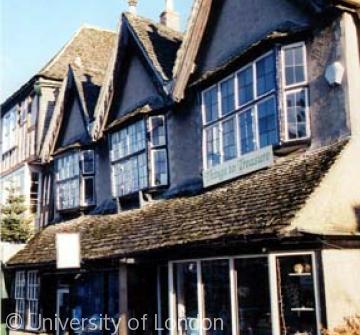High Street (east), Nos 111 and 113

In origin this is another jettied, timber-framed building with fine carved bargeboards of the late 15th century, built for an unknown owner and incorporating a shop from the outset. Traces survive inside of the medieval timber shopfront , and there are more medieval buildings to the rear. As a shop, the ground floor would originally have been unheated, but fireplaces and chimneys were added in the southern part (No. 113) in the 16th century, along with some fine wallpaintings. By 1607 and possibly much earlier the building was an inn called the Bull, occupied by the John Silvester who, in 1610, transferred to No. 105 (the surviving Bull). Internal investigation in 2002 showed that the three gables to the street were altered about that time, and the oriel windows added to the first floor.
From 1703 the house was divided into two unequal parts. The northern two thirds (No. 111) were let to an ironmonger and from the 1790s to a succession of butchers, while the southern part (No. 113) became the Wheatsheaf inn, possibly by the 1730s. Despite this division and a later (unrelated) division of ownership, the uniformity of the front was preserved. The 18th-century render has quoins picked out in a fine-textured material on both parts (e.g. around the oriel windows), while the stone-slate lean-to roof is also 18th-century.
The boxed-out shopfronts were added in the 19th and 20th centuries. At No. 111 the long tradition of butchering was continued first by the Warmington, Wiggins and Lomas families (1830s–c.1900), and from before 1911 by the Castles, who remained there (as WJ Castle Ltd) in 2007. Outside the shop are rails and hooks from which the carcasses hung, and at the rear is a former abattoir. At No. 113 the Wheatsheaf closed before 1871, when the building was occupied by a cooper: probably he used the well-lit structure which survives at the rear. By around 1938 No. 113 was a confectioner’s, and in 2007 a shop called Glass Heritage.
See: N Pevsner, Buildings of England: Oxfordshire (1974) 515; RH Gretton, The Burford Records (1920) 401–2, 445, 454, 474–5, 633; Oxfordshire Record Office, QSD V/3–4
Content generated during research for the paperback book 'Burford: Buildings and People in a Cotswold Town' (ISBN 13 : 9781860774881) for the England's Past for Everyone series








